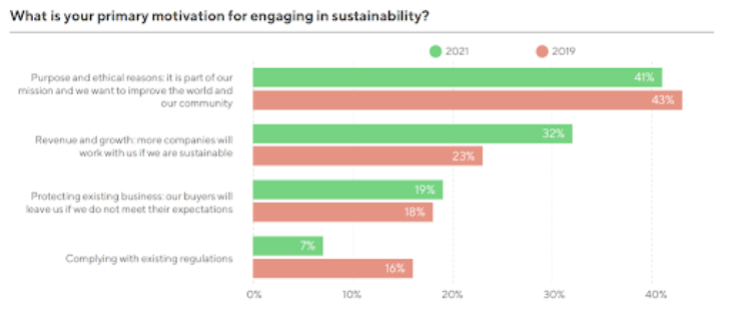Mid-Size Companies: The Next Frontier in Sustainable Procurement

Mid-Size Companies are Gaining Ground
This year, mid-size companies (between $100 million and $1 billion in annual revenue) made it clear that they are firmly in the sustainable procurement game. Due to the number of responses we received, we decided to perform our first analysis of mid-size companies to see how their practices compare with those of their larger peers.
We found that, although most of these companies are not as advanced as the global giants and use fewer and less advanced tools to assess their suppliers’ sustainability performance, they are gaining significant ground in the sustainable procurement space. In fact, a number of mid-size companies were identified as “Sustainable Procurement Leaders”, a select group of respondents that met stringent criteria related to their program maturity, integration of sustainability metrics, coverage of high-risk and strategic suppliers and level of supply chain visibility.
When it comes to deriving meaningful value from their sustainable procurement programs, mid-size companies lack the resources that large companies have and may find it more difficult to monitor the wide-ranging and detailed metrics and KPIs necessary to track their performance. They may also struggle to invest in a dedicated sustainability function for their company resilience (42% vs. 54% – mid-size vs. large respectively), savings costs (38% vs. 39%) and improved procurement metrics (38% vs. 35%). A larger gap between the two size groups under improved sustainability ranking is to be expected given that mid-size companies are simply less likely to be listed in financial and sustainability indices. Due to their limited resources, mid-size companies use fewer tools and tactics than large enterprises to drive sustainability practices in their supply chains. They rely more heavily on supplier self-assessment (52%) and while the preference for this tool is at the same level as for large enterprises, the difference in adoption of some of the other tactics is striking: third-party supplier sustainability databases (24% vs. 48%) and category/country risk (33% vs. 54%).
However, mid-size companies have certain advantages over large multinationals that may present them with unique and significant opportunities. They tend to be nimbler and, as a result, more able to innovate faster. They are also able to shape their sustainability strategy with less pressure from shareholders. This has enabled mid-size companies to keep pace with large enterprises in terms of the type of benefits they derive from their sustainable procurement programs. The top benefits realized by this group are the same as for large enterprises and include risk mitigation (59% vs. 70%), increased resilience (42% vs. 54%), cost savings (38% vs. 39%) and improved procurement metrics (38% vs. 35%).
Resilience is Key for Companies of All Sizes
While the pandemic impacted mid-size companies more severely than larger enterprises, our study shows that they remain equally steadfast to their sustainable procurement commitments. Encouragingly, nearly half of the companies in both size groups increased their commitment to sustainability and a similar proportion of companies reported no change in their attitude. However, there was a small proportion of companies that had to decrease their commitment to sustainable procurement as a result of the COVID-19 crisis (11%), the majority of which were mid-size companies. The economic impact of COVID-19 has inevitably constrained investment in sustainability among some companies with fewer resources, but feedback from buyers and suppliers makes it clear that the mid-size sector is increasingly realizing that building supply chain resilience through sustainable procurement will help them prepare for future crises.
Mid-size companies are poised to tap into a significant opportunity for growth and may represent the next frontier of sustainable procurement progress. Many of them are Tier 1 suppliers of multinational giants and, therefore, are uniquely positioned to drive sustainable procurement practices further down the supply chain. If you want more information on some of the key sustainable procurement trends that have emerged in the wake of the pandemic, read our full Barometer 2021 report.

